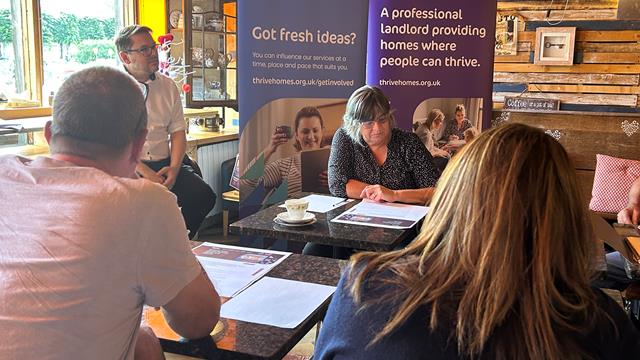Shaping our approach to handling damp and mould
It was great to get together with a small group of customers in July. We enjoyed tea, cake and had really useful conversations about the way we manage damp and mould in our homes.
To start the event, we shared our recently enhanced process for damp and mould cases.
Keeping a close eye
One of the main strengths of our process is making sure every single report or mention of damp and mould is recorded and monitored until both the customer and Thrive is satisfied that it is resolved. On the whole, customers felt this is an effective way of managing cases and we’ll be sharing details of the process on our website soon.
What, when and how
Each case is identified as mild, moderate or severe and will have its own plan of action. Customers suggested being clear on timescales so customers know what to expect. We are adding this into the process and making this information available on our website.
Whilst our website provides advice on how to treat damp and mould, customers said it would be useful if colleagues are also able to advise on this. We are going to train our customer facing colleagues on the latest advice, so they can provide this information clearly.
Safe and well
When a case is reported, we will consider how serious the issue is as well as any vulnerabilities in the household. It’s especially important that customers update their records regularly so we are aware of any needs of those living in your home.
To make sure we are keeping you safe in your home, we are going to make sure our advice meets the guidelines of the NHS.
Fair and effective advice
Customers felt the advice given to prevent and deal with damp and mould is useful. They suggested a number of improvements that we will be making as follows:
- Introduce the guidance in a balanced way that shows Thrive will work together with customers to deal with damp and mould.
- Review the order of the guidance, so customers can easily diagnose their problem and know what to do next.
- Add imagery so customers can understand what a mild, moderate or severe issue looks like.
- Add a way to upload multiple photos of the issue.
- Give advice on the type of products that can be used and where they can be purchased.
- Make sure customers are aware of how to access this information in a different language or read aloud.
- Produce a visual video that is up to 1minute 30seconds in length and educates customers on damp and mould and how to deal with it.
Next steps
Our team is already working on these actions, and we’ll let customers know once our updated website advice and video is ready to view!

